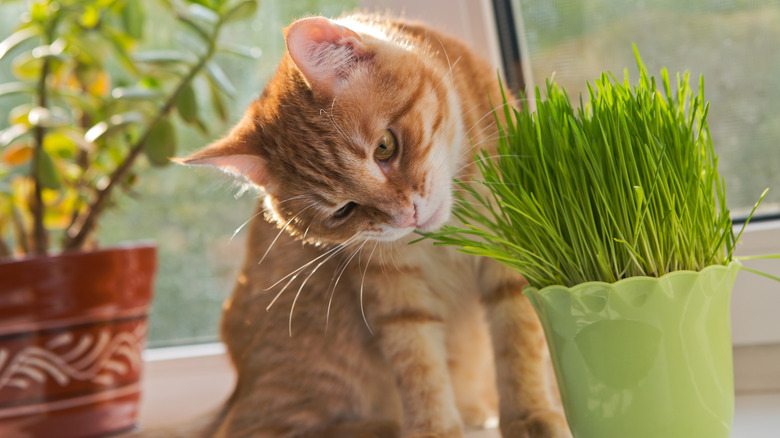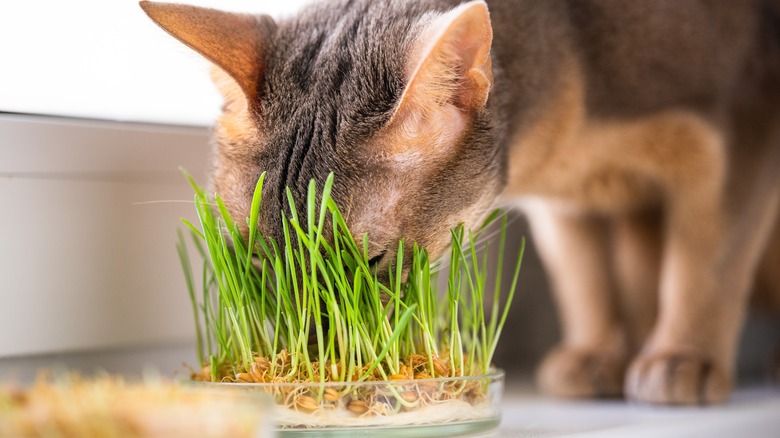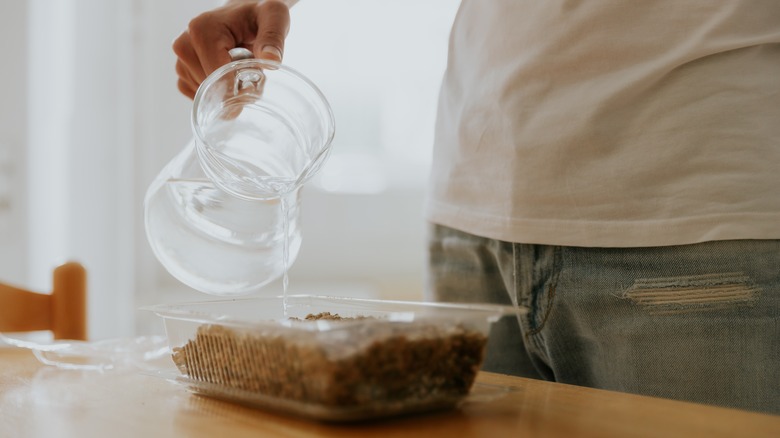How To Grow Cat Grass For All Its Benefits To Your Furry Friend
We may receive a commission on purchases made from links.
Houseplant enthusiasts may feel that their cat is one of the worst pests for their foliage. We know they aren't intentionally causing damage, so it's hard to stay mad at their adorable faces for long. Still, it's important to find simple ways to cat-proof your plants. Cat grass is a pet-safe plant that's different from what's growing in your yard, which could contain pesticides or other toxins. Better yet, growing cat grass is easy and involves soaking and sprouting the seeds, then placing the containers near a sunny window and keeping the soil moist until the grass is ready to be munched on.
There are several types of seeds you can choose to grow, including wheat, oat, barley, rye, and alfalfa. Each type provides several benefits, so the choice is up to you (and your cat). Test out a few varieties to see which one your kitty prefers. It's important to note that there are several houseplants that are actually poisonous to cats, with some even being fatal. Always double-check that your plants are cat-friendly or keep them out of reach.
So, what's the fascination with grass about? Although cats live on a mostly carnivore diet, they've evolved to process grass, too. In the wild, cats munch on some grass after consuming their prey. The extra grass might have aided them in vomiting undigested animal parts. Plus, the grass is rich in vital minerals and nutrients they need, which might be beneficial to your cat's health.
Benefits of cat grass
Typically, when you see your pet eating grass, you assume they're not feeling well. However, it's a myth that cats only nibble on grass when they're sick. While this is sometimes the case, there are other reasons they enjoy it. Grass contains folic acid, a vitamin found in their mother's milk, which helps produce hemoglobin, makes their digestive tract run more smoothly, and promotes healthy cell growth. That said, cats may be extra attracted to grass if they're struggling with vitamin deficiencies. If your pet is consuming an excessive amount of grass, talk to your veterinarian to make sure there aren't any underlying issues. Since cat grass should be given as a snack, it shouldn't make up more than 10% of their diet.
Even if your cat food is providing all of the nutrition your pet needs, they'll likely still enjoy a grassy treat from time to time. Many types of cat grasses contain vitamins, minerals, nutrients, fiber, and anti-inflammatory agents, making it a healthy supplement to consider. This tasty snack may also serve as a deterrent from other plants in your house. When they start eyeing your houseplants, redirect them to their cat grass container. Ideally, they'll learn to leave the other foliage alone and focus their attention on their own designated grassy area. Other plants you can grow that your cat will love include cat thyme, licorice root, and spider plants.
Growing your own kitty grass from seed
Growing cat grass is easy enough that even those with the blackest of thumbs should be able to pull it off. You can purchase kits with everything you need, such as this one from Amazon, or use a shallow planter with drainage holes. You can soak your seeds before you plant them or stick them directly in the dirt. In either case, make sure they stay damp while they germinate. Fill your planter three-fourths of the way with fresh potting soil. Spread the seeds over the top of the dirt before adding a top layer of soil. Water the surface thoroughly with a spray bottle and lay a sheet of plastic wrap over the top. Place the container in an area out of the sun while you wait for the seeds to sprout. You should see some green sprouts pop up within a few days to a week.
Once the grass starts emerging from the soil, you can remove the plastic wrap and place the container near a window that receives direct sunlight. Keep the soil moist, but make sure it doesn't get too wet, as excess water can promote mold growth. The grass will continue to grow over the next couple of weeks and will be ready to munch on when it's about 4 inches tall. When ready, you may want to place the planter in a weighted container to make it harder for your cat to swat off.


